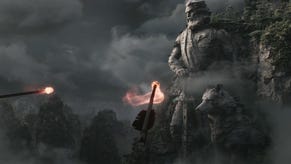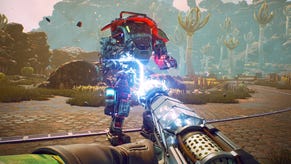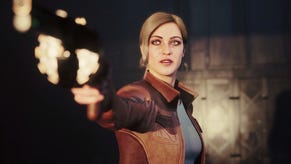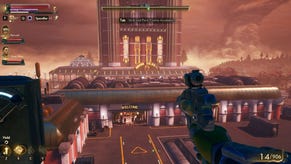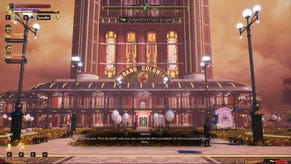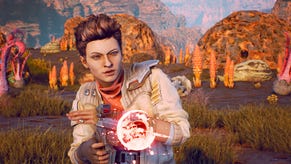What to Read, Play, and Watch Before Playing The Outer Worlds
Leonard Boyarsky and Tim Cain share the syllabus for their new RPG.
This article first appeared on USgamer, a partner publication of VG247. Some content, such as this article, has been migrated to VG247 for posterity after USgamer's closure - but it has not been edited or further vetted by the VG247 team.
Leonard Boyarsky and Tim Cain have slightly more esoteric tastes than your average game developer. Where many will point you to Star Wars or other blockbusters, Cain and Boyarsky are more likely to talk about fiction from the turn of the 20th century. That outlook has done a great deal to inform the unique style of games like Fallout, which they helped to create.
Their latest project, The Outer Worlds, is much the same. While it superficially resembles Futurama and Firefly (both of which, to be be fair, Cain cites as inspirations), its roots go quite a bit deeper. After all, Boyarsky in particular is the kind of guy who will nerd out to questions like, "What if William McKinley had never been shot?" or "What would the future look like if the microchip had never been invented?"
As we have with several other games now, I took the time to dig into some of these deeper inspirations. Here's what you should read, play, and watch before or after taking on The Outer Worlds.
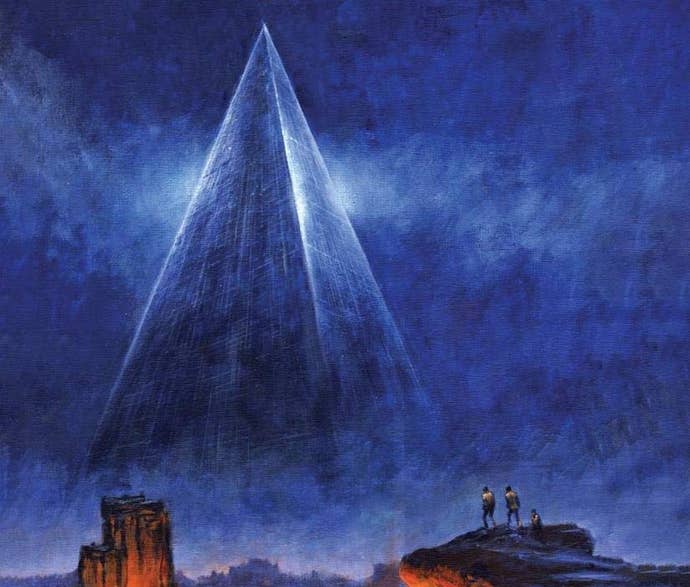
What to Read: "The Night Land" by William Hope Hodgson
Cain and Boyarsky struggle a little to come up with a single book to recommend for players. "True Grit," both the book and the movie, comes up as an example of the tone they're trying to strike with The Outer Worlds' setting. But Cain says their inspirations on this front are a bit of a hodge-podge.
"It's weird cause we do this kind of genre mixing this thing where I would say, yeah, go read a bunch of 1950s space opera stuff. But then go read a bunch of the history of the early 20th history where the robber barons didn't quite succeed in what they wanted to do," Cain explains.
Boyarsky does mention one book you might not heard of: "The Night Land," by William Hope Hodgson. First published in 1912, it posits a world in which the sun has gone out and humanity is battling shadowy forces from something called "The Last Redoubt." H.P Lovecraft himself described it as "one of the most potent pieces of macabre imagination ever written."
"I know I've suggested [The Night Land] to several people to give you an idea of what it's like to go against this unflappable array of monsters," Boyarsky says."
Boyarsky also refers to another item of interest from the early 20th century in referring to "N-Rays," which were hypothetized by French physicist Prosper-René Blondlot in 1903. "I directed them to a turn of the last century professor in France who believed he had discovered a whole new form of radiation, but was completely discredited and his career went away."
Naturally, they're real in The Outer Worlds. When combined with its gilded age influences and everything else, it's clear that The Outer Worlds really has an early 20th century sci-fi bent.
What to Watch: Brazil (directed by Terry Gilliam, 1985)
When senior narrative designer Megan Starks first joined The Outer Worlds, she says Boyarsky immediately asked her to watch Brazil, Terry Gilliam's surreal deconstruction of a hyper-bureaucratic society. "I think that movie was something that Tim and Leonard really liked for the dark humor, and just the crazy experience of what this alternate society is like," she says.
In Brazil, a low-level bureaucrat living in a dystopian future deals with terrorists, mistaken identities, and lots of paperwork. Darkly funny, it was famously the subject of some pretty intense studio battles over the ending. You can very much see the influence of Brazil in locations like Byzantium, a futuristic city plastered with advertisements.
"One thing we like about [Brazil] is that it's a dystopia that tries to put this veneer of everything being fine, and that you should just do your job," Cain says. "Our game has that same essence in its DNA. We were showing off Byzantium, and Byzantium is gorgeous, but it's got its problems. And yet people are just walking around happy as can be."
Cain specifically refers to a scene where a bomb goes off, but the main chararacter's mother is somehow totally unfazed. "All this terrible stuff was happening and she didn't care."
Brazil is regarded as a seminal work of science fiction, right up there with Blade Runner, so you should watch it in any case. Unfortunately, it's not available via many streaming platforms, so you will probably have to rent it via Amazon Prime.
What to Play: Vampire: The Masquerade - Bloodlines (Troika Games)
The Outer Worlds has drawn many comparisons with Fallout: New Vegas, and Cain and Boyarsky acknowledge that it's definitely an influence. But to get a real feel for what The Outer Worlds is all about, fans might want to go to the famously troubled RPG that Cain and Boyarsky made in the mid-2000s: Vampire: The Masquerade - Bloodlines.
"I liked working on Vampire," Cain says. "Somebody asked me recently if I've replayed any of my games recently, and I replayed [Vampire: The Masquerade - Bloodlines] a couple years ago. I picked a different clan, and it's super fun and it's held up, and I'm sorry it's taken 15 years for a sequel. I'm glad people waited."
In Bloodines, you play a newly-created vampire who must navigate the supernatural politics of Los Angeles. Its themes are heavily influenced by both sex and race, making it a standout for the time, even if it was barely what you could call "finished." We called it one of our Top 25 RPGs of All Time in last year's countdown for Axe of the Blood God.
As for how it relates to The Outer Worlds, Boyarsky says it's to do with their desire to explore the impact of various systems on society, "In our canon, we try to get really deep into the social systems of what that world was because we felt like there really hadn't been a fantasy game that really dealt with how these races interacted and how these races would feel about each other, other than just kind of like a very surface thing. So we tried to explore that. In this, we're trying to explore these corporations that are running the world the way they want. There's nothing standing in their way. This is the perfect utopia for corporations, and what would that mean."
Bloodlines remains a cult favorite to this day, and is even getting a sequel in 2020. You can read our coverage of it here.
So there you have it: three pieces of media you should read, play, and watch if you're interested in The Outer Worlds. Want to know more? Check out our full review. The Outer Worlds is out on PS4, Xbox One, and PC on October 25, with a Switch release to come at a later date.



